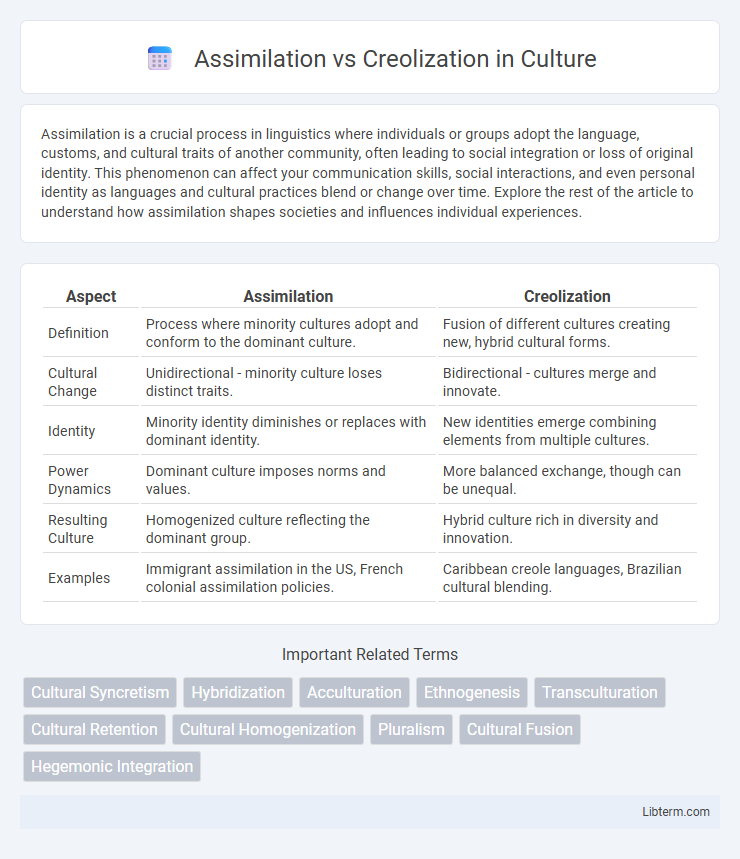Assimilation is a crucial process in linguistics where individuals or groups adopt the language, customs, and cultural traits of another community, often leading to social integration or loss of original identity. This phenomenon can affect your communication skills, social interactions, and even personal identity as languages and cultural practices blend or change over time. Explore the rest of the article to understand how assimilation shapes societies and influences individual experiences.
Table of Comparison
| Aspect | Assimilation | Creolization |
|---|---|---|
| Definition | Process where minority cultures adopt and conform to the dominant culture. | Fusion of different cultures creating new, hybrid cultural forms. |
| Cultural Change | Unidirectional - minority culture loses distinct traits. | Bidirectional - cultures merge and innovate. |
| Identity | Minority identity diminishes or replaces with dominant identity. | New identities emerge combining elements from multiple cultures. |
| Power Dynamics | Dominant culture imposes norms and values. | More balanced exchange, though can be unequal. |
| Resulting Culture | Homogenized culture reflecting the dominant group. | Hybrid culture rich in diversity and innovation. |
| Examples | Immigrant assimilation in the US, French colonial assimilation policies. | Caribbean creole languages, Brazilian cultural blending. |
Understanding Assimilation: Definition and Concepts
Assimilation refers to the process by which individuals or groups adopt the cultural traits of another group, often leading to the reduction of distinct cultural identities. This concept involves the absorption of language, customs, and social behaviors, typically resulting in the dominant culture prevailing over minority cultures. Understanding assimilation requires examining its impact on cultural diversity and the dynamics of power within societies.
Defining Creolization: Key Features and Origins
Creolization refers to the dynamic process where diverse cultures, languages, and traditions blend to form new, distinct identities, often emerging in colonial or multicultural settings. Key features include linguistic hybridity, cultural syncretism, and the creation of novel social norms that transcend original cultural boundaries. Its origins are deeply rooted in historical contexts of colonization, migration, and trade, where sustained contact between different groups stimulated unique cultural transformations.
Historical Context: Assimilation and Creolization in Society
Assimilation and creolization represent two distinct historical processes in the formation of societies, where assimilation involves the absorption and integration of minority groups into a dominant culture, often erasing original cultural identities. Creolization, by contrast, emerges in colonial and trade settings, blending diverse cultural elements to create new, hybrid social and linguistic forms, as seen in Caribbean and Afro-American communities. Understanding these processes reveals how historical power dynamics, migration, and cultural exchange shape societal transformation and identity formation.
Cultural Identity: Impact on Communities
Assimilation often leads to the erosion of original cultural identities as minority groups adopt the dominant culture's norms and values, resulting in diminished cultural diversity within communities. Creolization, by contrast, fosters the blending of multiple cultural elements, creating new, hybrid identities that enrich communal cultural landscapes and promote mutual understanding. The impact on communities involves varying degrees of cultural preservation, with assimilation typically causing cultural homogenization and creolization encouraging cultural innovation and inclusivity.
Linguistic Dimensions: Language Transformation
Assimilation involves the gradual adoption of a dominant language, leading to the erosion of the original linguistic features, while creolization results in the development of a new, stable language combining elements from multiple source languages. Linguistic transformation in assimilation often entails language shift and loss of heritage dialects, whereas creolization produces distinct grammatical structures and vocabulary reflecting cultural hybridity. Both processes highlight dynamic language evolution influenced by social interaction, power relations, and cultural exchange.
Power Dynamics in Assimilation and Creolization
Assimilation often reflects dominant power dynamics where a minority group is pressured or compelled to adopt the cultural norms of a dominant group, leading to cultural erasure or marginalization. Creolization, by contrast, emerges from more reciprocal interactions between different cultures, fostering hybrid identities through mutual exchange and adaptation rather than one-sided dominance. Power imbalances in assimilation manifest as forced conformity, whereas creolization involves negotiated cultural blending, highlighting the varying impacts on identity and social hierarchy.
Influences on Art, Music, and Literature
Assimilation often results in dominant cultural elements blending into minority art, music, and literature, leading to a reduction in distinct ethnic styles and traditional expressions. Creolization fosters the creation of new, hybrid cultural forms by merging diverse influences, seen in genres like reggae, calypso, and Creole literature that combine African, European, and indigenous elements. This process enriches cultural landscapes by producing innovative artistic expressions that reflect pluralistic identities and social interactions.
Case Studies: Real-World Examples
Assimilation is exemplified by the Native American experience in the United States, where policies like the Indian boarding schools sought to absorb Indigenous peoples into mainstream Euro-American culture, often erasing native languages and traditions. Creolization is vividly illustrated by the cultural blend in the Caribbean, where African, European, and Indigenous influences merged to create unique languages such as Haitian Creole and syncretic religious practices. These case studies reveal assimilation's tendency to enforce cultural conformity, while creolization fosters hybrid identities that reshape cultural landscapes.
Social Integration: Challenges and Outcomes
Assimilation often results in the minority group adopting the dominant culture's norms and values, sometimes leading to the loss of original cultural identity, while creolization fosters the blending of distinct cultural elements into a new, hybrid culture that preserves aspects of all contributing groups. Social integration in assimilation can face challenges such as cultural erasure and resistance from marginalized communities, whereas creolization promotes inclusivity and mutual respect by valuing cultural diversity. Outcomes of assimilation may include social cohesion at the expense of diversity, whereas creolization tends to produce dynamic, multicultural societies with enriched social fabrics.
Future Trends: Evolving Theories and Practices
Future trends in assimilation and creolization emphasize dynamic intercultural interactions shaping hybrid identities and linguistic landscapes. Emerging theories prioritize fluidity and reciprocal exchange over unidirectional cultural absorption, highlighting digital communication's role in accelerating cultural blending. Practices increasingly incorporate collaborative frameworks that respect diversity while fostering inclusive communal development.
Assimilation Infographic

 libterm.com
libterm.com